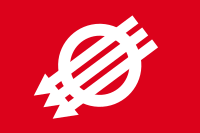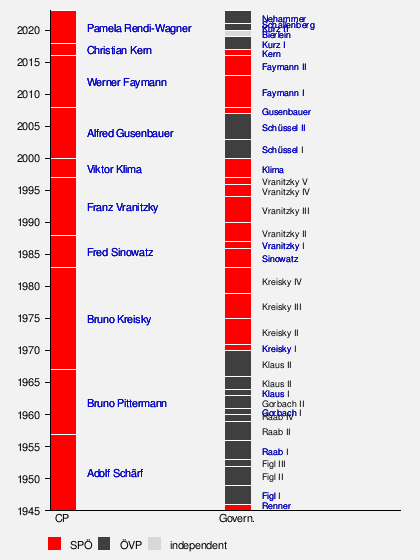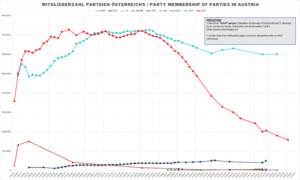Social Democratic Party of Austria facts for kids
Quick facts for kids
Social Democratic Party of Austria
Sozialdemokratische Partei Österreichs
|
|
|---|---|
 |
|
| Abbreviation | SPÖ |
| Chairperson | Andreas Babler |
| Parliamentary leader | Andreas Babler & Philip Kucher |
| Managing director | Klaus Seltenheim & Sandra Breiteneder |
| Notable deputy chairpersons |
See list
|
| Founder | Victor Adler |
| Founded | 1 January 1889 |
| Headquarters | Löwelstraße 18, 1040 Vienna |
| Student wing | Socialist Students of Austria |
| Youth wing | Junge Generation, Socialist Youth Austria |
| Paramilitary wing | Republikanischer Schutzbund (1923–1934) |
| Membership (2023) | c. 140,000 |
| Ideology | Social democracy |
| Political position | Centre-left |
| European affiliation | Party of European Socialists |
| International affiliation |
|
| European Parliament group | Progressive Alliance of Socialists and Democrats |
| Colours | Red |
| Anthem |
"Song of Labour" |
| National Council |
40 / 183
|
| Federal Council |
18 / 60
|
| Governorships |
3 / 9
|
| State cabinets |
5 / 9
|
| State diets |
133 / 440
|
| European Parliament |
5 / 19
|
| Party flag | |
 |
|
The Social Democratic Party of Austria (in German: Sozialdemokratische Partei Österreichs), often called SPÖ, is a political party in Austria. It was started in 1889 as the Social Democratic Workers' Party of Austria. This makes it the oldest political party still active in Austria today.
The SPÖ is known as a social democratic party. This means it believes in things like fairness, equality, and helping everyone in society. It is considered a centre-left party.
Since June 2023, Andreas Babler has been the leader of the party. The SPÖ is currently the second largest party in the National Council, which is like Austria's main parliament. It has 40 out of 183 seats. The party also has members in the parliaments of all nine Austrian states. It is the biggest party in three of these states: Burgenland, Carinthia, and Vienna.
The SPÖ supports Austria being a member of the European Union. It is also part of bigger groups of similar parties in Europe and around the world. These include the Party of European Socialists and the Progressive Alliance. The SPÖ works closely with groups that represent workers, like the Austrian Trade Union Federation.
Contents
A Brief History of the SPÖ
The SPÖ has played a very important role in Austrian politics for a long time. It was founded in 1889. At the start of World War I, it was the strongest party in Austria's parliament.
After World War I ended in 1918, the party leader, Karl Renner, became the head of the government for a short time. This was during the First Austrian Republic. Even when the SPÖ was not in power, it had many supporters.
In the 1920s, the party was very popular. About 15% of all Austrians were part of a group linked to the SPÖ. In 1929, it had 720,000 members. The party was especially strong among working-class people.
"Red Vienna"
From 1919 to 1934, the Social Democrats were in charge of the city of Vienna. During this time, Vienna became known as "Red Vienna". The city government started many new projects to help people. They built 60,000 new homes for workers. They also made medical care free for everyone. New taxes were put on high incomes and luxury goods to pay for these services.
The city also focused on culture and education for working-class people. Many cinemas and theaters opened with support from the city. Sports also became more available to everyone. This period was a unique time when socialist ideas were put into practice in a big city.
Difficult Times and Rebuilding
In 1934, the democratic system in Austria was overthrown by another political party. The Social Democrats and Communists tried to fight back, but their resistance was quickly stopped. The SPÖ was banned and not allowed to exist during this time. This ban continued when Nazi Germany took over Austria in 1938, leading to World War II.
After World War II ended in 1945, the party was started again. It was renamed the Socialist Party of Austria (SPÖ). Adolf Schärf became its leader. The SPÖ joined the government of the Second Republic. They worked with another major party, the Austrian People's Party (ÖVP), until 1966. Karl Renner, the former leader, became the first President of Austria in the new republic.
Leading the Country
From 1971 to 1983, the SPÖ was the only party in charge of the government. This was under the leadership of Bruno Kreisky. He was the Chancellor and won three elections in a row.
From 1987 to 2000, the SPÖ led a "grand coalition" with the ÖVP. This meant the two biggest parties worked together to govern. In 1991, the party changed its name back to the Social Democratic Party of Austria.
After 2000, the SPÖ was in opposition for a while. However, one of its members, Heinz Fischer, was elected president in 2004. The party was part of the government again from 2007 to 2017. Since 2017, the SPÖ has been the main opposition party.
Recent Changes
In early 2023, there was a discussion within the party about its future direction. This led to a new election for the party leader. Andreas Babler, the mayor of Traiskirchen, became the new leader in June 2023.
Looking at the Past (1938-1945)
The SPÖ has looked closely at its role during the time of Nazi Germany (1938-1945). Even though the party was banned, some former members joined the Nazi Party. The SPÖ opened its records to understand this period better.
In 2005, a report was published about these "brown spots" in the party's history. This report talked about former SPÖ members who became part of the Nazi Party.
Leaders like President Heinz Fischer have also spoken openly about Austria's past. He said that the idea of Austria being only a "victim" of Nazi Germany was not entirely true. He pointed out that Austrian Jewish victims were not mentioned in some important declarations after the war. He also said it took too long for victims to receive help. This shows how Austria and its political parties have worked to understand their history honestly.
Chairpersons since 1945
The chart below shows a timeline of the social-democratic chairpersons and the Chancellors of Austria since 1945. The left bar shows all the chairpersons (Bundesparteivorsitzende, abbreviated as CP) of the SPÖ, and the right bar shows the corresponding make-up of the Austrian government at that time. The red (SPÖ) and black (ÖVP) colours correspond to which party led the federal government (Bundesregierung, abbreviated as Govern.). The last names of the respective chancellors are shown, with the Roman numeral standing for the cabinets.

Other Important SPÖ Politicians
Here are some other well-known politicians from the SPÖ:
- Josef Broukal, a journalist and member of parliament.
- Josef Cap, who used to lead the party's group in parliament.
- Johanna Dohnal, who was the first minister for women's affairs.
- Christoph Matznetter, who speaks for the party on money matters.
- Barbara Prammer, who was the first female president of the National Council.
Groups Within the SPÖ
Like many big parties, the SPÖ has different groups within it. Some groups, like Der Funke (which means "The Spark"), have more radical socialist ideas. The youth group, SJ Austria, is also seen as being more left-wing than the main party.
Election Results
The SPÖ has taken part in many elections throughout its history. These include elections for the Imperial Council, the National Assembly, the National Council, the Presidency, and the European Parliament. They also participate in elections for the state parliaments across Austria.
National Council Election Results
| Election | Votes | % | Seats | +/– | Government |
|---|---|---|---|---|---|
| 1920 | 1,072,709 | 36.0 (#2) |
69 / 183
|
Opposition | |
| 1923 | 1,311,870 | 39.6 (#2) |
68 / 165
|
Opposition | |
| 1927 | 1,539,635 | 43.3 (#2) |
71 / 165
|
Opposition | |
| 1930 | 1,517,146 | 41.1 (#1) |
72 / 165
|
Opposition | |
| 1945 | 1,434,898 | 44.6 (#2) |
76 / 165
|
ÖVP–SPÖ–KPÖ majority | |
| 1949 | 1,623,524 | 38.7 (#2) |
67 / 165
|
ÖVP–SPÖ majority | |
| 1953 | 1,818,517 | 42.1 (#1) |
73 / 165
|
ÖVP–SPÖ majority | |
| 1956 | 1,873,295 | 43.0 (#2) |
74 / 165
|
ÖVP–SPÖ majority | |
| 1959 | 1,953,935 | 44.8 (#1) |
78 / 165
|
ÖVP–SPÖ majority | |
| 1962 | 1,960,685 | 44.0 (#2) |
76 / 165
|
ÖVP–SPÖ majority | |
| 1966 | 1,928,985 | 42.6 (#2) |
74 / 165
|
Opposition | |
| 1970 | 2,221,981 | 48.4 (#1) |
81 / 165
|
SPÖ minority supported by FPÖ | |
| 1971 | 2,280,168 | 50.0 (#1) |
93 / 183
|
SPÖ majority | |
| 1975 | 2,326,201 | 50.1 (#1) |
93 / 183
|
SPÖ majority | |
| 1979 | 2,413,226 | 51.0 (#1) |
95 / 183
|
SPÖ majority | |
| 1983 | 2,312,529 | 47.6 (#1) |
90 / 183
|
SPÖ–FPÖ majority | |
| 1986 | 2,092,024 | 43.1 (#1) |
80 / 183
|
SPÖ–ÖVP majority | |
| 1990 | 2,012,787 | 42.8 (#1) |
80 / 183
|
SPÖ–ÖVP majority | |
| 1994 | 1,617,804 | 34.9 (#1) |
65 / 183
|
SPÖ–ÖVP majority | |
| 1995 | 1,843,474 | 38.1 (#1) |
71 / 183
|
SPÖ–ÖVP majority | |
| 1999 | 1,532,448 | 33.2 (#1) |
65 / 183
|
Opposition | |
| 2002 | 1,792,499 | 36.5 (#2) |
69 / 183
|
Opposition | |
| 2006 | 1,663,986 | 35.3 (#1) |
68 / 183
|
SPÖ–ÖVP majority | |
| 2008 | 1,430,206 | 29.3 (#1) |
57 / 183
|
SPÖ–ÖVP majority | |
| 2013 | 1,258,605 | 26.8 (#1) |
52 / 183
|
SPÖ–ÖVP majority | |
| 2017 | 1,351,918 | 26.9 (#2) |
52 / 183
|
Opposition | |
| 2019 | 1,011,868 | 21.2 (#2) |
40 / 183
|
Opposition |
Presidency Election Results
| Election | Candidate | First round result | Second round result | ||||
|---|---|---|---|---|---|---|---|
| Votes | % | Result | Votes | % | Result | ||
| 1951 | Theodor Körner | 1,682,881 | 39.1 | Runner-up | 2,178,631 | 52.1 | Won |
| 1957 | Adolf Schärf | 2,258,255 | 51.1 | Won | |||
| 1963 | Adolf Schärf | 2,473,349 | 55.4 | Won | |||
| 1965 | Franz Jonas | 2,324,436 | 50.7 | Won | |||
| 1971 | Franz Jonas | 2,487,239 | 52.8 | Won | |||
| 1974 | Rudolf Kirchschläger | 2,392,367 | 51.7 | Won | |||
| 1980 | Rudolf Kirchschläger | 3,538,748 | 79.9 | Won | |||
| 1986 | Kurt Steyrer | 2,061,104 | 43.7 | Runner-up | 2,107,023 | 46.1 | Lost |
| 1992 | Rudolf Streicher | 1,888,599 | 40.7 | Runner-up | 1,915,380 | 41.1 | Lost |
| 1998 | No candidate | ||||||
| 2004 | Heinz Fischer | 2,166,690 | 52.4 | Won | |||
| 2010 | Heinz Fischer | 2,508,373 | 79.3 | Won | |||
| 2016 | Rudolf Hundstorfer | 482,790 | 11.3 | 4th place | |||
| 2022 | No candidate | ||||||
European Parliament Election Results
| Election | Votes | % | Seats | +/– |
|---|---|---|---|---|
| 1996 | 1,105,910 | 29.2 (#2) |
6 / 21
|
|
| 1999 | 888,338 | 31.7 (#1) |
7 / 21
|
|
| 2004 | 833,517 | 33.3 (#1) |
7 / 18
|
|
| 2009 | 680,041 | 23.7 (#2) |
4 / 17
|
|
| 2014 | 680,180 | 24.1 (#2) |
5 / 18
|
|
| 2019 | 903,151 | 23.9 (#2) |
5 / 18
|
Images for kids
See also
 In Spanish: Partido Socialdemócrata de Austria para niños
In Spanish: Partido Socialdemócrata de Austria para niños
- Austro-Marxism
- Proletář
- Socialist Students of Austria



